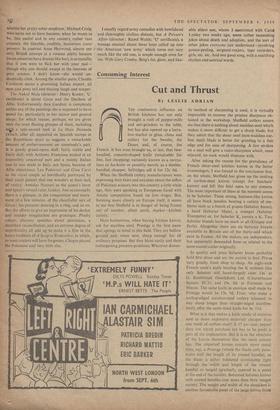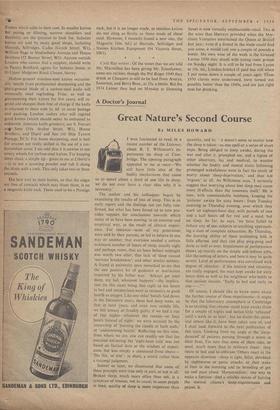Consuming Interest
Cut and Thrust
By LESLIE ADRIAN When the Sheffield cutlery manufacturers were expressing their fears and anxieties about the influx of Pakistani scissors into this country a little while ago, they. were speaking as Europeans faced with Asiatic competition based on low wages. But, focusing more closely on Europe itself, it seems to me that Sheffield is in danger of being frozen out of another, albeit small, market—kitchen cutlery.
Most housewives, when buying kitchen knives, ask for stainless steel. Prestige is the first name that springs to mind in this field. They are hollow ground and, when new, sharp enough for all ordinary purposes. But they blunt easily and their resharpening presents problems. Whatever domes-
tic method of sharpening is used, it is virtually impossible to recover the pristine sharpness ob- tained in the workshop. Sheffield cutlers assure me that there is nothing about stainless steel which makes it more difficult to get a sharp blade, but they admit that the shear steel (non-stainless car- bon steel) blade is better for grinding to a fine edge and for ease of sharpening. A few strokes on a steel will give a razor-sharpness which, once enjoyed, no cook would dispense with.
After asking the reason for the prevalence of French shear-steel kitchen knives in the better ironmongers, 1 was forced to the conclusion that, on the whole, Sheffield has given up the making of carbon-steel knives (except for butchers' knives) and left this field open to any corners. The most important of these at the moment seems to be Sabatier. These strong, business-like knives all have black handles bearing a variety of em- blems such as a bunch of grapes (Sabatier Jeune), a hand (Sabatier Main), a trumpet (Sabatier Trompette) or, for Sabatier K, merely a K. Two Sabatier brands have no mark at all (Unique and Perle). Altogether there are six Sabatier brands available in Britain out of the thirty-odd which exist in France. All the makers are independent, but apparently descended from or related to the same master-cutler originally.
In quality and price Sabatier Jeune probably hold first place and are the easiest to find. Prices vary greatly from shop to shop. An eight-inch French cook's knife bearing the K emblem (the only Sabatier still hand-forged) costs 14s. at G. Rushbrook (Smithfield) Ltd. (Charterhouse Square, EC1), and 19s. 6d. at Fortnum and Mason. The same knife in stainless steel made by Prestige would be 13s. 9d. Friar, who make a scallop-edged stainless-steel cutlery (claimed to stay sharp longer than straight-edged stainless- steel), offer the same-sized knife for 9s. 11d.
What is it that makes a knife made of stainless steel (a more expensive material) cheaper than one made of carbon steel? A 17 per cent. import duty (on which purchase tax has to be paid) is part of the explanation. But it is in the structure of the knives themselves that the main answer lies. The imported knives contain more metal than, say, a Prestige (where the blade only pene- trates half the length of its riveted handle), as the blade is either bolstered (continuing right through the 'width and length of the riveted handle) or tanged (gradually tapered to a point at the end of the handle). Bolstered Sabatier knives with riveted handles cost more than their tanged variety. The weight and width of the shoulders is another favourable point of the large knives from France which adds to their cost. In smaller knives for paring or filleting, narrow shoulders and flexibility arc the f,eatures to look for. Sabatier knives are sold by many good shops, including Harrods, Selfridges, Cadec (Greek Street, WI), William Page in Shaftesbury Avenue and House Brothers (52 Brewer Street, WI). Anyone outside London who cannot find a supplier, should write to Pazery Bouffard, agents for Sabatier Jeune, at 10 Upper Mulgrove Road, Cheam, Surrey.
Hollow-ground stainless-steel knives occasion- ally benefit from professional sharpening and the plain-ground blade of a carbon-steel knife will eventually need regrinding. Friar, as well as guaranteeing their knives for five years, will re- grind and sharpen them free of charge if the knife is returned to them with Is. 6d. to cover postage and packing. London cutlers who will regrind good knives (which should never be entrusted to unknown, itinerant knife-grinders), are S. Ferrari anvl, Sons (10a Archer Street, WI), House Brothers, and Dipre and Son (10 Ship Tavern Passage. EC3). For home sharpening, steel is best for anyone not really skilled in the use of a car- borundum stone. I am told that it is unwise to use emery wheels for carbon-steel knives. For keeping them clean, a simple tip—given to me at Liberty's —is to use a scouring powder and rub it along the blade with a cork. This only takes two or three seconds.
The best way to store knives, so that the edges are free of contacts which may blunt them, is on a nragnetic knife rack. There used to be a Prestige rack, but it is no longer made, as stainless knives do not cling as firmly as those made of shear steel. However, I recently found a new one, the Magnette (10s. 6d.) at Harrods, Selfridges and Staines Kitchen Equipment (94 Victoria Street, SW1).
Cyril Ray writes : Of the wines that we are told Mr. Macmillan has been giving Mr. Eisenhower, some are rarities, though the Pol Roger 1949 they drank at Chequers is still to be had from Averys, Justerinis, and Berry Bros., at 35s. a battle. But the 1934 Latour they had on Monday at Downing
Street is now virtually unobtainable retail. This is the wine that Harveys provided when the Mer- chant Venturers entertained the Queen at Bristol last year; even if a friend in the trade could find you some, it would cost you a couple of pounds a bottle. My own wine of the week is the Gruaud Larose 1950 they drank with young roast grouse on Sunday night. It is still to be had from Lyons at 10s. 6d., London-bottled (I paid less still when I put some down a couple of years ago). These 1950 clarets were underrated, have turned out possibly better than the 1949s, and are just right now for drinking.



































 Previous page
Previous page